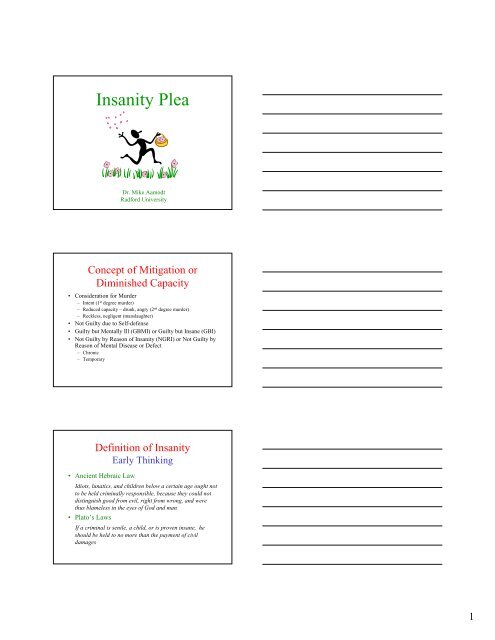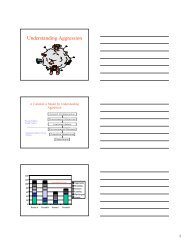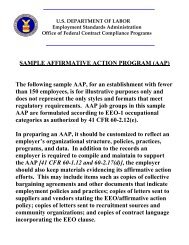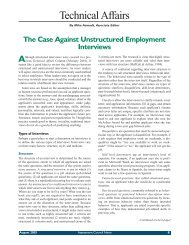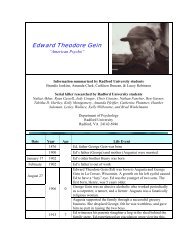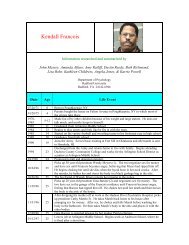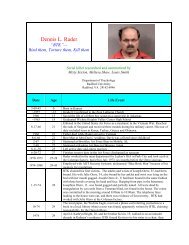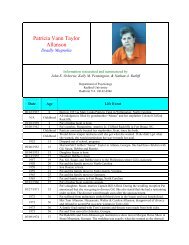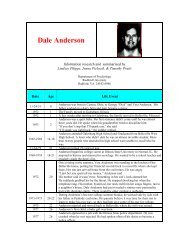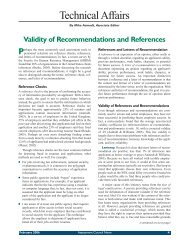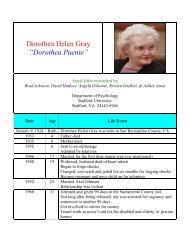Insanity Plea - Dr. Mike Aamodt - Radford University
Insanity Plea - Dr. Mike Aamodt - Radford University
Insanity Plea - Dr. Mike Aamodt - Radford University
Create successful ePaper yourself
Turn your PDF publications into a flip-book with our unique Google optimized e-Paper software.
<strong>Insanity</strong> <strong>Plea</strong><br />
<strong>Dr</strong>. <strong>Mike</strong> <strong>Aamodt</strong><br />
<strong>Radford</strong> <strong>University</strong><br />
Concept of Mitigation or<br />
Diminished Capacity<br />
• Consideration for Murder<br />
– Intent (1 st degree murder)<br />
– Reduced capacity – drunk, angry (2 nd degree murder)<br />
– Reckless, negligent (manslaughter)<br />
• Not Guilty due to Self-defense<br />
• Guilty but Mentally Ill (GBMI) or Guilty but Insane (GBI)<br />
• Not Guilty by Reason of <strong>Insanity</strong> (NGRI) or Not Guilty by<br />
Reason of Mental Disease or Defect<br />
– Chronic<br />
– Temporary<br />
Definition of <strong>Insanity</strong><br />
Early Thinking<br />
• Ancient Hebraic Law<br />
Idiots, lunatics, and children below a certain age ought not<br />
to be held criminally responsible, because they could not<br />
distinguish good from evil, right from wrong, and were<br />
thus blameless in the eyes of God and man<br />
• Plato’s Laws<br />
If a criminal is senile, a child, or is proven insane, he<br />
should be held to no more than the payment of civil<br />
damages<br />
1
Definition of <strong>Insanity</strong><br />
Early Thinking<br />
• Marcus Aurelius<br />
Madness is its own sole punishment<br />
• Shakespeare’s Hamlet<br />
If I wrong someone when not myself, then Hamlet does it<br />
not, Hamlet denies it. Who does it then? His madness.<br />
Definition of <strong>Insanity</strong><br />
Historic Timeline<br />
1226 Perhaps the first recorded consideration of forensic madness<br />
• Ralph killed a man<br />
• Because he was “out of his wits and senses”, he was sentenced to<br />
life in prison rather than death<br />
1265 Henri de Bracton: “An insane person is a person who does<br />
does not know what he is doing, is lacking in mind and reason,<br />
and is not far removed from the brutes.”<br />
1270 Richard Blofot not released from prison due to madness<br />
1275 <strong>Insanity</strong> is recognized as a defense by English common law<br />
Definition of <strong>Insanity</strong><br />
Historic Timeline<br />
1278 First NGRI, Hugh de Misyn<br />
• Killed his daughter<br />
• King Edward “Hugh hanged his daughter whilst suffering from<br />
madness, and not by felony or of malice aforethought.”<br />
• Released to the custody of 12 men who pledged to keep him under<br />
control<br />
1307 King Edward II – A person is insane if their mental ability is<br />
no greater than a “wild beast”<br />
1581 Difference between “good or evil” rule<br />
1838 Isaac Ray published “A treatise of medical jurisprudence”<br />
2
Definition of <strong>Insanity</strong><br />
M’Naghten Rule<br />
• Daniel McNaughton in 1843<br />
– A deluded Scotsman<br />
– Thought the Prime Minister (Sir Robert Peel) was persecuting him<br />
– Tried to shoot him and instead killed his secretary<br />
– Ruled insane and spent 20 years in a mental asylum until his death<br />
• McNaughton Rule<br />
To establish a defense on the grounds of insanity, it must be<br />
clearly proved that, at the time of committing the act, the<br />
party accused was labouring under such a defect of<br />
reason, from disease of the mind, as not to know the<br />
nature and quality of the act he was doing; or if he did<br />
know it, that he did not know that what he was doing was<br />
wrong.<br />
Definition of <strong>Insanity</strong><br />
New Hampshire Rule<br />
• New Hampshire Rule (1869)<br />
Test of criminal responsibility is whether the act was the offspring or<br />
product of mental disease in the defendant<br />
• Judge David Bazelon and The Durham<br />
Experiment (1954)<br />
Year % of trials pleading NGRI<br />
1954 0.4<br />
1955 1.8<br />
1958 3.3<br />
1959 6.1<br />
1960 8.8<br />
1961 14.4<br />
Definition of <strong>Insanity</strong><br />
American Law Institute (ALI)<br />
• Becomes the new standard in 1962<br />
• Is now used in about half the states<br />
• A person is not responsible for criminal conduct if at the<br />
time of such conduct, as a result of mental disease or<br />
defect, he lacks substantial capacity either to appreciate<br />
the criminality of his conduct or t conform his conduct to<br />
the requirements of the law.<br />
• The terms “mental disease” or “defect” do not include an<br />
abnormality manifested only be repeated criminal or<br />
otherwise anti-social conduct<br />
3
Definition of <strong>Insanity</strong><br />
<strong>Insanity</strong> Defense Reform Act (1984)<br />
• Motivated by the NGRI finding for John Hinckley<br />
following 1982 assassination attempt of President<br />
Reagan<br />
• 1984 IDRA covers Federal trials<br />
– Eliminated the volitional prong<br />
– Prohibited experts from giving opinions about the<br />
defendant’s insanity<br />
– Placed the burden of proof on the defendant (clear and<br />
convincing evidence)<br />
Mental disease<br />
Act was a product of<br />
mental disease<br />
Did not know what he<br />
was doing<br />
Did not know what he<br />
was doing was wrong<br />
Could not stop himself<br />
from committing the act<br />
Definition of <strong>Insanity</strong><br />
Summary of Definitions<br />
M’Naghten<br />
<br />
<br />
<br />
New<br />
Hampshire<br />
<br />
<br />
ALI<br />
Research suggests that the actual standard used probably has<br />
little impact on the verdict (Ogloff, 1991)<br />
Definition of <strong>Insanity</strong><br />
Virginia<br />
• Mental disease or defect, and<br />
• Did not understand what he<br />
was doing (or)<br />
• Did not know what he was<br />
doing was wrong (or)<br />
• Was not able to control the<br />
impulse to act<br />
<br />
<br />
<br />
Federal<br />
<br />
<br />
<br />
4
State<br />
Rule<br />
Not allowed<br />
M’Naughten<br />
ALI<br />
Pure<br />
+ volitional<br />
Pure<br />
- volitional<br />
Durham<br />
Alabama<br />
Alaska<br />
Arizona<br />
Arkansas<br />
California<br />
Colorado<br />
Connecticut<br />
Delaware<br />
D.C.<br />
Florida<br />
Georgia<br />
State<br />
Hawaii<br />
Idaho<br />
Illinois<br />
Indiana<br />
Iowa<br />
Kansas<br />
Kentucky<br />
Louisiana<br />
Maine<br />
Maryland<br />
Massachusetts<br />
Standard<br />
M’N<br />
M’N<br />
M’N<br />
ALI<br />
M’N<br />
M’N +<br />
ALI<br />
ALI -<br />
ALI<br />
M’N<br />
M’N<br />
Standard<br />
ALI<br />
None<br />
ALI -<br />
ALI -<br />
M’N<br />
None<br />
ALI<br />
M’N<br />
ALI -<br />
ALI<br />
ALI<br />
State Summary<br />
# of<br />
States<br />
5<br />
19<br />
5<br />
18<br />
4<br />
1<br />
States (+ D.C. * Puerto Rico)<br />
Idaho, Montana, Utah, Nevada, Kansas<br />
Colorado, Missouri, New Mexico, Texas, Virginia<br />
Delaware, Illinois, Indiana, Maine<br />
New Hampshire<br />
Didn’t Know What<br />
They Were Doing<br />
(M’N)<br />
X<br />
X<br />
X<br />
X<br />
X<br />
X<br />
X<br />
Didn’t Know What<br />
They Were Doing<br />
(M’N)<br />
X<br />
X<br />
Cognitive Prong<br />
Cognitive Prong<br />
Didn’t Know it<br />
was Wrong<br />
(ALI+M’N)<br />
X<br />
X<br />
X<br />
X<br />
X<br />
X<br />
X<br />
X<br />
X<br />
X<br />
X<br />
Didn’t Know it<br />
was Wrong<br />
(ALI+M’N)<br />
X<br />
X<br />
X<br />
X<br />
X<br />
X<br />
X<br />
X<br />
Volitional Prong<br />
Couldn’t Stop<br />
Behavior (ALI)<br />
X<br />
X<br />
X<br />
X<br />
Volitional Prong<br />
Couldn’t Stop<br />
Behavior (ALI)<br />
X<br />
X<br />
X<br />
X<br />
X<br />
5
State<br />
Michigan<br />
Minnesota<br />
Mississippi<br />
Missouri<br />
Montana<br />
Nebraska<br />
Nevada<br />
New Hampshire<br />
New Jersey<br />
New Mexico<br />
New York<br />
State<br />
N. Carolina<br />
N. Dakota<br />
Ohio<br />
Oklahoma<br />
Oregon<br />
Pennsylvania<br />
Puerto Rico<br />
Rhode Island<br />
South Carolina<br />
South Dakota<br />
Tennessee<br />
State<br />
Texas<br />
Utah<br />
Vermont<br />
Virginia<br />
Washington<br />
West Virginia<br />
Wisconsin<br />
Wyoming<br />
Standard<br />
ALI<br />
M’N<br />
M’N<br />
M’N +<br />
None<br />
M’N<br />
None<br />
Durham<br />
M’N<br />
M’N +<br />
ALI<br />
ALI<br />
Didn’t Know<br />
What They Were<br />
Doing (M’N)<br />
X<br />
X<br />
X<br />
X<br />
X<br />
X<br />
X<br />
Cognitive Prong<br />
Didn’t Know it<br />
was Wrong<br />
(ALI+M’N)<br />
Cognitive Prong<br />
Didn’t Know Didn’t Know it<br />
Standard What They Were was Wrong<br />
Doing (M’N) (ALI+M’N)<br />
M’N<br />
X<br />
X<br />
ALI<br />
X<br />
M’N<br />
X<br />
X<br />
M’N<br />
X<br />
X<br />
ALI<br />
X<br />
M’N<br />
X<br />
X<br />
ALI<br />
X<br />
ALI<br />
X<br />
M’N<br />
X<br />
X<br />
M’N<br />
X<br />
X<br />
Standard<br />
M’N +<br />
None<br />
ALI<br />
M’N +<br />
M’N<br />
ALI<br />
ALI<br />
ALI<br />
Didn’t Know<br />
What They Were<br />
Doing (M’N)<br />
X<br />
X<br />
X<br />
Cognitive Prong<br />
X<br />
X<br />
X<br />
X<br />
X<br />
X<br />
X<br />
X<br />
X<br />
Didn’t Know it<br />
was Wrong<br />
(ALI+M’N)<br />
X<br />
X<br />
X<br />
X<br />
X<br />
X<br />
X<br />
Volitional Prong<br />
Couldn’t Stop<br />
Behavior (ALI)<br />
X<br />
X<br />
X<br />
X<br />
Volitional Prong<br />
Couldn’t Stop<br />
Behavior (ALI)<br />
X<br />
X<br />
X<br />
X<br />
Volitional Prong<br />
Couldn’t Stop<br />
Behavior (ALI)<br />
X<br />
X<br />
X<br />
X<br />
X<br />
X<br />
6
Media Darlings<br />
Serial Killers<br />
Assassins<br />
School Shooters<br />
Famous Cases<br />
Found NGRI<br />
Lorena Bobbit<br />
Ed Gein (WI)<br />
Jeanne Weber (France)<br />
John Hinckley<br />
Susan Smith<br />
Art Shawcross<br />
Jeff Dahmer<br />
John Wayne Gacy<br />
David Berkowitz<br />
Herbert Mullin<br />
Jack Ruby<br />
Sirhan Sirhan<br />
Arthur Bremmer<br />
Charles Guiteau<br />
Kip Kinkel<br />
NGRI?<br />
Found Sane<br />
Found GBMI<br />
John du Pont<br />
Michael Carneal<br />
Randy Jones killed five women over a six-year span. After<br />
each killing, he mutilated and then buried the bodies. On one<br />
occasion, Jones was almost pulled over by a police officer<br />
while one of the victims was in his car. However, Jones was<br />
able to elude the officer. Jones was examined by two<br />
psychologists, both of whom agreed that he suffered from<br />
antisocial personality disorder.<br />
___ Mental disorder<br />
___ Did not know what he was doing<br />
___ Did not know what he was doing was wrong<br />
___ Could not stop his behavior<br />
NGRI?<br />
Marc Cohen killed his wife and three children. He told<br />
police that a voice kept telling him to kill his family. The<br />
distress from hearing the voice became so great that Cohen<br />
decided to kill his wife and children. He pled NGRI,<br />
claiming that the voice made him do it and that he couldn’t<br />
stop. None of the three psychologists who examined him<br />
could find any signs of a psychological disorder.<br />
___ Mental disorder<br />
___ Did not know what he was doing<br />
___ Did not know what he was doing was wrong<br />
___ Could not stop his behavior<br />
7
NGRI?<br />
Over a 3-year period, Sandy Beach killed five tourists who<br />
threw trash into the ocean. She considered it her job to<br />
protect the ocean and its inhabitants. She was finally caught<br />
when she attacked a sixth tourist in front of a police officer<br />
and then sat down on the beach.<br />
___ Mental disorder<br />
___ Did not know what she was doing<br />
___ Did not know what she was doing was wrong<br />
___ Could not stop her behavior<br />
• Nationwide (1995)<br />
– 9 pleas per 1,000 felony<br />
cases (about 1%)<br />
– 26% success rate<br />
– 2.6 out of 1,000 defendants<br />
are found NGRI<br />
• Virginia<br />
– About 500 sanity<br />
evaluations conducted<br />
annually<br />
– About 30 NGRI acquittals<br />
each year<br />
Location<br />
Baltimore<br />
New Jersey<br />
New York<br />
City<br />
Wyoming<br />
NGRI Frequency<br />
NGRI Frequency<br />
Year<br />
1991<br />
1982<br />
1982<br />
1979<br />
Cases<br />
60,432<br />
32,000<br />
21,102<br />
• Baltimore (1991)<br />
– 60,432 indictments<br />
– 190 pleaded NGRI<br />
– 182 dropped the NGRI<br />
prior to trial<br />
– Defense and prosecution<br />
agreed that the remaining 8<br />
were NGRI<br />
NGRI <strong>Plea</strong><br />
190(0.31%)<br />
52 (0.16%)<br />
0.14%<br />
102 (0.48%)<br />
Successful<br />
8 (4.2%)<br />
15 (28.8%)<br />
1(0.98%)<br />
8
Who <strong>Plea</strong>ds NGRI?<br />
Type of Crime<br />
• Nationwide, 14.3% involve homicide<br />
• State differences<br />
– 44% in New York<br />
– 30% in Michigan<br />
– 20% in New Jersey<br />
– 16% in Missouri<br />
– 7% in Oregon<br />
Murder<br />
Property crime<br />
Assault<br />
Attempted murder<br />
Sexual assault<br />
Who <strong>Plea</strong>ds NGRI<br />
Type of Crime<br />
Silver et al.<br />
14.3<br />
31.6<br />
Rogers<br />
20.5<br />
20.0<br />
31.8<br />
1.6<br />
Who <strong>Plea</strong>ds NGRI?<br />
Class of Crime<br />
• Class A felonies 23%<br />
• Class B felonies 36%<br />
• Class C felonies 25%<br />
• Class D felonies 9%<br />
• Misdemeanors 7%<br />
Linhorst & Dirks-Linhorst, 1997 - Missouri<br />
Linhorst<br />
16<br />
11<br />
25<br />
11<br />
9
• Most are<br />
– Unemployed<br />
–Lower SES<br />
Who <strong>Plea</strong>ds NGRI?<br />
Demographics<br />
Who <strong>Plea</strong>ds NGRI?<br />
Agreement<br />
• Psychologists agree 92% of the<br />
time (Fukunaga et al., 1981)<br />
• Prosecution and defense agree<br />
42.9% of the time (Cirincione,<br />
1996)<br />
Side<br />
Defense<br />
Defense<br />
Defense<br />
Prosecution<br />
Prosecution<br />
Court<br />
Court<br />
Agreement in Dahmer Case<br />
Expert<br />
Fred Berlin<br />
Judith Becker<br />
Carl Wahlstrom<br />
Fred Fosdal<br />
Park Dietz<br />
Sam Friedman<br />
George Palermo<br />
Disorder<br />
Necrophilia<br />
Necrophilia<br />
Borderline personality<br />
Paraphilia & alcohol<br />
dependence<br />
Personality disorder<br />
Personality disorder<br />
Insane?<br />
Yes<br />
Yes<br />
Yes<br />
No<br />
No<br />
No<br />
No<br />
10
Factors Related to Success<br />
of NGRI <strong>Plea</strong>s -The Defendant<br />
• Older<br />
• Female (Towers, 1996; Morris, 1992)<br />
• Better educated (Morris, 1992)<br />
• Single<br />
• History of prior hospitalization (82% had been hospitalized<br />
at least once)<br />
• Considered extremely disturbed (89% were schizophrenic<br />
or mentally retarded)<br />
• Details of the crime are unusual (Pickel, 1998)<br />
• Race and SES are not related (Pasewark, Towers, &<br />
McGinley)<br />
Factors Related to Success<br />
of NGRI <strong>Plea</strong>s -The Court<br />
• Female jurors are more<br />
sympathetic (Blau, McGinley, &<br />
Pasewark, 1992)<br />
• Religious people are less<br />
sympathetic (Tygart, 1992)<br />
• Judges more sympathetic than<br />
jurors<br />
State<br />
Montana<br />
Georgia<br />
Ohio<br />
United States<br />
Wisconsin<br />
New York<br />
New Jersey<br />
California<br />
Washington<br />
Factors Related to Success<br />
of NGRI <strong>Plea</strong>s -The State<br />
Success %<br />
7.31<br />
13.11<br />
15.30<br />
26.27<br />
28.24<br />
39.78<br />
43.34<br />
45.52<br />
87.36<br />
<strong>Plea</strong> %<br />
5.74<br />
1.73<br />
1.36<br />
.93<br />
1.59<br />
.29<br />
.53<br />
.58<br />
.60<br />
Idaho, Wyoming, and Utah have abolished the insanity plea<br />
11
Results of <strong>Plea</strong>ding NGRI<br />
• In general,<br />
– People who win usually spend more time in<br />
mental hospital than they would have in prison<br />
– People who lose spend more time in prison than<br />
they would had they not pled NGRI<br />
• Receive sentences 22% longer than non-NGRI<br />
pleaders<br />
• 67% of unsuccessful NGRI pleaders went to prison<br />
compared to 11% of all felony arrests<br />
Source: Braff, Arcinites, & Steadman (1983)<br />
Results of <strong>Plea</strong>ding NGRI<br />
People Successfully <strong>Plea</strong>ding NGRI<br />
• 84.7% are sent to a mental hospital<br />
– Murderers spend an average of 76.4 months<br />
– Others spend an average of 32.5 months<br />
• 15.3% are set free<br />
– 11.6% receive a conditional release<br />
– 2.6% receive outpatient therapy<br />
– 1.1% receive an outright release<br />
Source: Silver et al (1994)<br />
Designer Defenses<br />
12
Designer Defenses<br />
• Coined by Barbara Kirwin<br />
• “New and curious psychological syndromes<br />
concocted complete with the requisite expert<br />
testimony to exonerate someone who is definitely<br />
sane, frequently psychopathic, and most frequently<br />
deserving of punishment.”<br />
• Key Points<br />
– Person committed the crime<br />
– They knew what they were doing, knew it was wrong, and<br />
could control their behavior<br />
– They have a “mental disorder” – you just can’t find it in the<br />
DSM-IV<br />
– Their sentence should be minimal because the crime was<br />
not their fault<br />
Myth of the Twinkie Defense<br />
• 1979<br />
• Supervisor Dan White kills San Francisco<br />
Mayor George Moscone and Supervisor<br />
Harvey Milk<br />
• White defense argues that he was depressed<br />
and not acting normal<br />
– Martin Blinder<br />
• White charged with murder but jury returns<br />
verdict of voluntary manslaughter (sentenced<br />
to 7 years, 8 months)<br />
• Press labels “Twinkie defense”<br />
• White paroled 1-6-84 after 5 years and 1<br />
month<br />
• Committed suicide on 10-21-85<br />
Our Study<br />
• Independent Study in Spring, 2005<br />
– Heather Mitchell, Amanda Alfaro, Ricky Gray, and Brittany Taylor<br />
– Presented paper at annual meeting of the Society for Police and<br />
Criminal Psychology (Scottsdale, AZ)<br />
• Research legal cases to find examples of designer defenses<br />
• Research Questions<br />
– How often are they used?<br />
– Do they work?<br />
– If so, under what circumstances?<br />
• Our hypothesis: Designer defenses would work best when the<br />
jury needed a reason to find the person not guilty<br />
– Victim “needed killing”<br />
– Defendant was likable<br />
13
Analysis Hurdles<br />
• Did the case provide enough information?<br />
• Separating the actual effect of the designer defense on<br />
the verdict from other factors<br />
• What is success?<br />
– Not guilty<br />
– Reduced sentence<br />
– Guilty but no punishment<br />
– Hung jury<br />
• No control group with which to compare success<br />
rates<br />
Results<br />
193 Cases of “Designer Defense”<br />
• Battered Child Syndrome (30)<br />
• Cultural Defense (24)<br />
• Battered Woman Syndrome<br />
(21)<br />
• Postpartum Depression (17)<br />
• Automatism (14)<br />
• Sleepwalking (13)<br />
• Homosexual Panic Disorder (9)<br />
• Black Rage (6)<br />
• Adopted Child Syndrome (7)<br />
“One Hit Wonders”<br />
• Twinkie Defense<br />
• Automatism of<br />
Penfield<br />
• Clerambault-<br />
Kandinsky Syndrome<br />
• Crocodile Dundee<br />
Syndrome<br />
• Distant Father<br />
Syndrome<br />
• Rock and Roll<br />
Defense<br />
• Meek Mate Syndrome<br />
• PMS (4)<br />
• Prozac Defense (4)<br />
• Vietnam Syndrome (3)<br />
• Battered Spouse (3)<br />
• Urban Survival Syndrome<br />
(2)<br />
• Mob Mentality (2)<br />
• Mother Lion Defense (2)<br />
• Genetics Defense (2)<br />
• God Told Me To (2)<br />
• Minister Made Me Do<br />
It<br />
• Sleep Apnea<br />
• Steroid Defense<br />
• Transient Situational<br />
Disturbance<br />
• Unhappy Gay Sailor<br />
Syndrome<br />
• Computer Addiction<br />
• Fan Obsession<br />
Syndrome<br />
14
Usually Used in Homicide Cases<br />
• Homicide (75.9%)<br />
– Homicide (71.4%)<br />
– Attempted homicide (3.0%)<br />
– Solicitation of murder (1.5%)<br />
• Assault (4.1%)<br />
• <strong>Dr</strong>unk driving (3.1%)<br />
• Sexual assault/rape (2.0%)<br />
• Robbery (1.5%)<br />
Who <strong>Plea</strong>d?<br />
• 59.9% were men<br />
•Race<br />
– 66.3% were white<br />
– 11.2% were African American<br />
– 9.0% were Asian<br />
– 7.9% were Hispanic<br />
– 3.4% were Native American Indian<br />
Aspects of the Trial<br />
• Type<br />
– Jury (77.5%)<br />
– Bench (18.6%)<br />
– <strong>Plea</strong> bargain (3.9%)<br />
• Use of Expert Witness<br />
– Yes (52.7%)<br />
– Not attempted (28.6%)<br />
– Attempted but judge disallowed (16.5%)<br />
– Used but jury instructed to ignore (2.2%)<br />
15
Did the Defense Work?<br />
• No (49.4%)<br />
• Yes (50.6%)<br />
– Reduction in sentence (24.4%)<br />
– Not guilty (11.3%)<br />
– NGRI (8.1%)<br />
– Guilty but no punishment (5.6%)<br />
– Hung jury (1.3%)<br />
Factors Related to Success<br />
• Victim Likable*<br />
– No (64.9%)<br />
– Yes (37.9%)<br />
• Defendant Likable*<br />
– No (16.2%)<br />
– Yes (65.3%)<br />
• Sex of Defendant<br />
– Male (44.4%)<br />
– Female (62.1%)<br />
• Trial Type<br />
– Bench (54.2%)<br />
– Jury (45.5%)<br />
• Use of Expert<br />
– No (45.0%)<br />
– Yes (42.6%)<br />
Success Rate by Likability<br />
Defendant Likable<br />
Victim Likable No Yes<br />
No 0.0% 60.0%<br />
Yes 15.2% 37.5%<br />
16
Success of <strong>Plea</strong><br />
Not Successful<br />
Successful<br />
Not guilty<br />
NGRI<br />
Hung jury<br />
Cases<br />
Guilty of lesser charge<br />
Guilty – no punishment<br />
Trial Results<br />
Battered<br />
Child<br />
30<br />
13<br />
57%<br />
3<br />
0<br />
2<br />
11<br />
1<br />
Battered<br />
Woman<br />
17<br />
10<br />
41%<br />
Cultural Defenses<br />
Cultural Defense<br />
2<br />
1<br />
0<br />
4<br />
0<br />
Automatism<br />
17%<br />
• Uses the excuse that the defendant’s culture<br />
has different laws, social interactions, and<br />
traditions than the United States<br />
• The crime committed in the U.S. would not<br />
have been a crime in the defendant’s native<br />
country<br />
12<br />
10<br />
0<br />
1<br />
0<br />
1<br />
0<br />
Sleepwalking<br />
12<br />
3<br />
75%<br />
4<br />
3<br />
0<br />
2<br />
0<br />
17
People vs. Kimura<br />
• Fumiko Kimura<br />
– Santa Monica, California 1985<br />
– Kimura found out that her husband was cheating on her.<br />
– 33-year old Fumiko Kimura walked into ocean with<br />
intentions to commit suicide and kill her two children.<br />
Kimura survived, but her children both died.<br />
– Kimura was trying to commit ''oyaku-shinju,'' a Japanese<br />
custom of parent-child suicide, which is acceptable when a<br />
spouse is cheating.<br />
– Charged with two counts of first-degree murder.<br />
– <strong>Plea</strong>d guilty<br />
– Received 1 year in jail, that had already been served during<br />
the hearing.<br />
State vs. Ganal<br />
• Orlando Ganal<br />
– Waipahu, Hawaii 1996<br />
– Ganal found out that his wife was cheating on him.<br />
– Killed mother-in-law and father in law in pursuit of<br />
cheating wife, shot own son, tracked down wife's lover<br />
and burned down the lover's brother’s home killing him<br />
and his two children.<br />
– Ganal argued that in his Malaysian culture, when stress<br />
builds up one “runs amok.”<br />
– Charged with first degree murder<br />
– Received life without parole<br />
Cultural Defense Results<br />
• 17 of the 21 cases had male defendants<br />
• Success<br />
– 21 cases<br />
– Worked in 10<br />
• Worked best when defendant was likable<br />
18
Postpartum Depression Psychosis<br />
Sheryl Lynn Massip<br />
• 1987, California<br />
• Mid-twenties year of age<br />
• Ran over her 6 week old son repeatedly with her<br />
car, killing him<br />
• Attempted to cover up the murder<br />
• Confessed when discovered<br />
• Charged with 2 nd degree murder, then lessened to<br />
voluntary manslaughter<br />
• Found NGRI by jury<br />
Sharon Comitz<br />
• 1985, California<br />
• <strong>Dr</strong>opped her 1 month old son off a bridge,<br />
killing him<br />
• Convicted of manslaughter<br />
• Received a sentence of 8-20 years in prison<br />
19
Did the Defense work?<br />
• 18 Cases<br />
– 4 were not successful<br />
– 14 were successful<br />
• NGRI in 8<br />
• Reduced sentence in 2<br />
• No jail time in 4<br />
Homosexual Panic Disorder<br />
Jonathan Schmitz<br />
• 1995, Michigan<br />
• 25 years old<br />
• Homosexual crush revealed on the Jenny<br />
Jones Show<br />
• Schmitz shot and killed admirer after show<br />
aired<br />
• Received a lessened sentence from 1 st degree<br />
to 2 nd degree murder<br />
• 25-50 years in prison sentence<br />
20
Aurelio Rivera<br />
• 1984, Arizona<br />
• Stabbed and killed a homosexual man after<br />
the victim made a sexual advance on the<br />
defendant<br />
• Received a life sentence with a 1 st degree<br />
murder conviction<br />
Did the Defense work?<br />
Number of<br />
cases<br />
Defense<br />
worked<br />
1<br />
Defense<br />
didn’t work<br />
5<br />
Unknown<br />
1<br />
21


